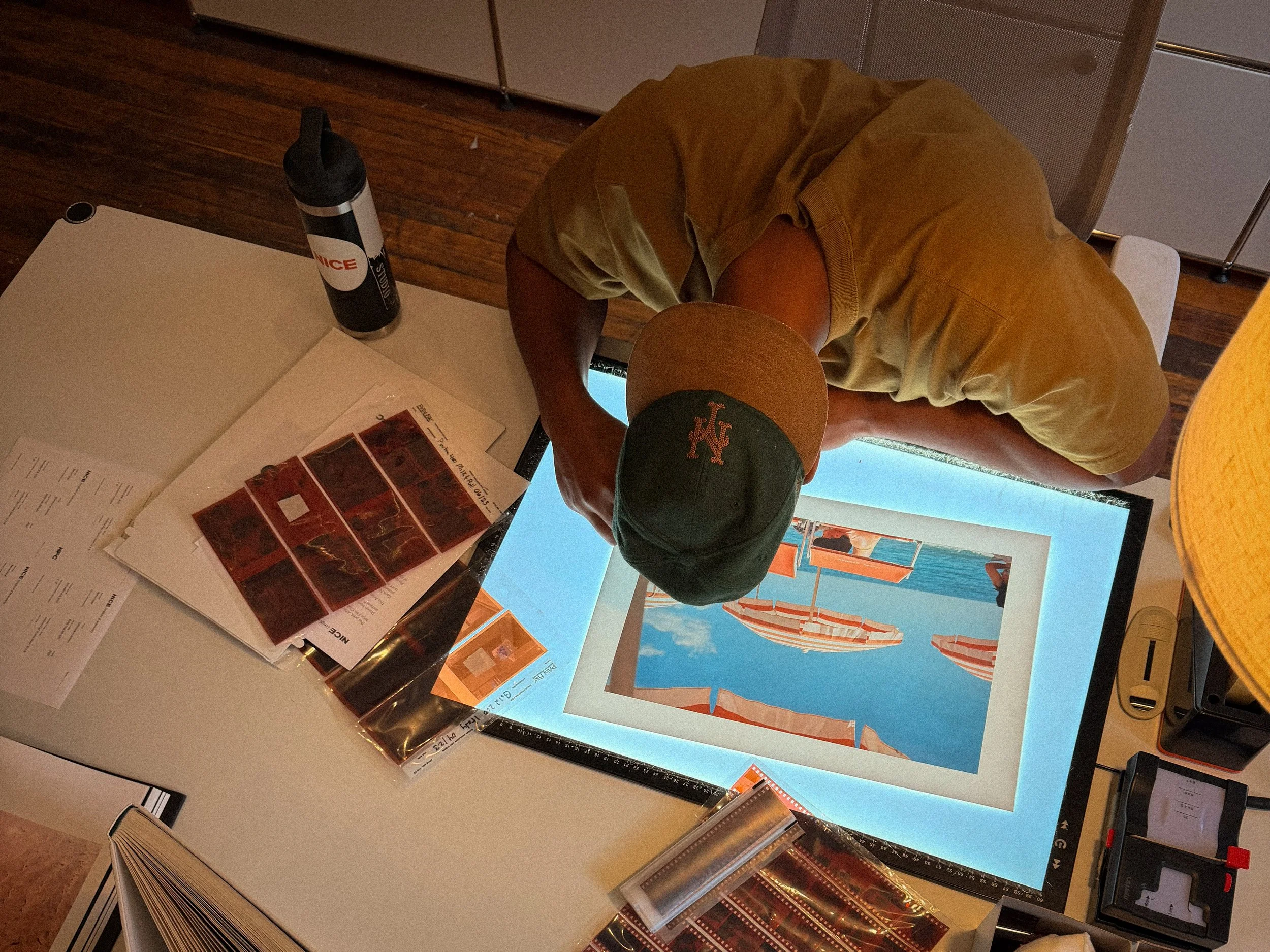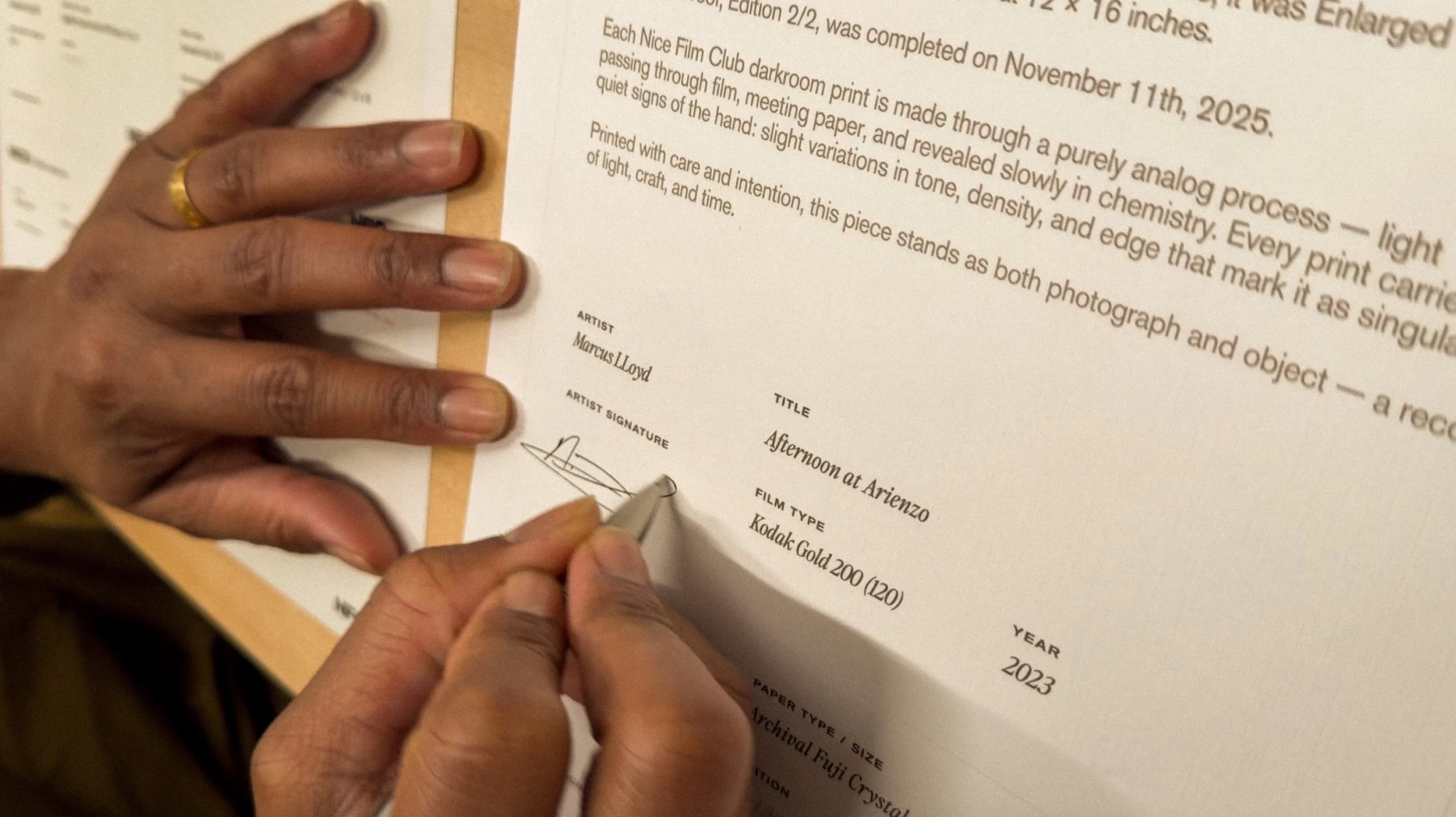Marcus Lloyd on Film Photography, Process, and Inspiration
We sat down with our new ambassador and soon-to-be part of the Darkroom Collection, Marcus Lloyd, to talk about his journey with film, what draws him into the darkroom, and the moments in the analog process that keep him inspired.
How did your journey with film photography begin, and what first drew you to shooting on analog instead of digital?
My journey with film started sort of out of necessity. I couldn’t afford the latest new Canon cameras at the time, whatever Mark IV it was, and I was really on a quest to create a certain depth and texture in my images. I came across a Pentax Spotmatic for really cheap. While I had to pay for film and dev and scans, in my mind it was a cheaper way to create unique images. With digital, it’s so easy to fire off a hundred frames and fix things later, but film forced me to be intentional. I fell in love with the ritual of loading the roll, hearing the clicks, not knowing if I got the shot until days later. It brought me back to the essence of seeing. There’s a certain honesty in film that I crave.
You’ve shot in so many different environments, from city streets to quiet moments of everyday life. What kinds of moments draw your eye when you’re shooting on film?
I feel the true practice is the quest to always be as present as possible. I’m drawn to everything; the subject itself is always changing. It’s things like light that I’m constantly studying and creating around. Colors draw me in too, it could be a lush beach scene with blue water, green from trees, and a pop of color from the lounge chairs, or the pop of red from a Negroni. But light and color are the two elements that I’m always looking for, and I begin composing around those.
“Ooooooo this is about to be fun.”
- Marcus Lloyd
Your upcoming darkroom print collection with Nice Film Club captures an intimate sense of place and rhythm. What inspired this body of work and how did these images come together?
These images came together with an intentional approach and collaboration with the NICE team. I shoot so many subject matters and different scenes, and the variety can be a bit overwhelming to narrow down into a set, but that’s honestly the fun part. From dramatic morning light pouring into a coffee shop to colorful beach scenes, these are all moments that remind me of being present and noticing these passing moments that are always right in front of us.
Why did you decide to print your shots, and what makes the darkroom process feel so special to you?
The darkroom process is very intimate — not just because you’re essentially alone in the dark lol, but because of the intention you begin to take with one single image. It’s a whole new level of slowing down in a process that already forces you to slow down. I’m also just a sucker for craftsmanship in so many forms; it’s a way for me to dive into my craft even more.
Marcus’s view of the Brooklyn Bridge.
Community is a big part of film photography… how has being part of that community influenced the way you shoot or think about your work?
Community is everything if I’m being real. Conversations with other photographers keep me energized and spark new ideas. Sharing my work with peers has actually brought out a new sense of trust. I can have an idea in my head of what I think the strongest images are, but when I share and see the excitement over an image I completely overlooked, it’s shown me to always be sharing your work. Get it out.
It keeps me from getting too heady about it all and just reminds me to make work. Also, it’s just fun to sit back over coffee and geek out about cameras and film stocks sometimes lol.
“Don’t rush the process. Keep it fun. The mistakes make you better because that’s where your voice or eye begins to develop. Shoot for yourself, not the algorithm. ”
How do you see film and darkroom printing fitting into today’s creative landscape, especially as digital and AI tools evolve?
I think it allows photographers to lean into the art of the work they want to make. I always find myself zigging when everyone is zagging. It’s just the natural pulse of who I am. It’s funny because all these digital and AI tools are here to make the “perfect” image, but oddly enough, it’s taking the soul right out of it all. I’m not on that journey; I want my work to have a feeling.
Marcus’s lens captures moments from his travels through Italy.
If someone is just starting to explore film or darkroom printing, what advice would you give them?
Don’t rush the process. Keep it fun. The mistakes make you better because that’s where your voice or eye begins to develop. Shoot for yourself, not the algorithm. And print your work, seeing your images off-screen will change the way you shoot forever.
This is your first collaboration with Nice Film Club in the darkroom. What has that experience been like so far?
It’s been incredible. Working with Ian and Josh on these prints has been so much fun and intentional. Ian is crazy talented and dialed in. I can just hang with these guys all day in the darkroom tweaking images to get them just right. Matter of fact — Ian, when you going to be back in the lab?
On another note, I’m not sure people realize the level of quality and precision that NICE is aiming for. I was blown away when Josh took me on a tour of the lab and what they’re working on, from 3D-printing darkroom parts that no longer exist, to refining the process, to wanting to bring the awareness of darkroom prints to the forefront as a true art form. And they should be viewed as such.
Marcus at the Nice Darkroom signing the Certificate of Authenticity.
When you first saw your negatives turned into test prints, what was your initial reaction?
Ooooooo this is about to be fun.
How do you think about editing or sequencing your images?
Sequencing for me is about rhythm, not just visual rhythm, but emotional rhythm. I look for flow and breath between images. I like when an image leads you to the next one without spelling out the story too much.
Film photography asks for patience. How has that shaped your creative rhythm or approach?
It’s freed me up; it keeps me in the moment. It’s taught me trust. You can’t check the back of the camera. Once I advance that film, it’s done nothing we can do about it. And I find it a pleasant surprise when you get the film back. It’s fun to have those moments of, “Oh yeah, I remember this moment. Wow, it turned out cool.”
ABOUT
Marcus Lloyd is a New York-based photographer specializing in travel, architecture, and street documentary. With a cinematic eye and a love for film photography, he transforms everyday moments into evocative stories that feel like glimpses of an untold journey. Each image invites viewers to wander hidden streets, discover secret interiors, and experience the thrill of places yet to be explored.
Marcus Lloyd darkroom prints are coming soon to the Nice Editions Collection. In the meantime, check out Nice Film Club Darkroom Services or shop Nice Darkroom Prints while you wait for the next drop. Members get first access.






